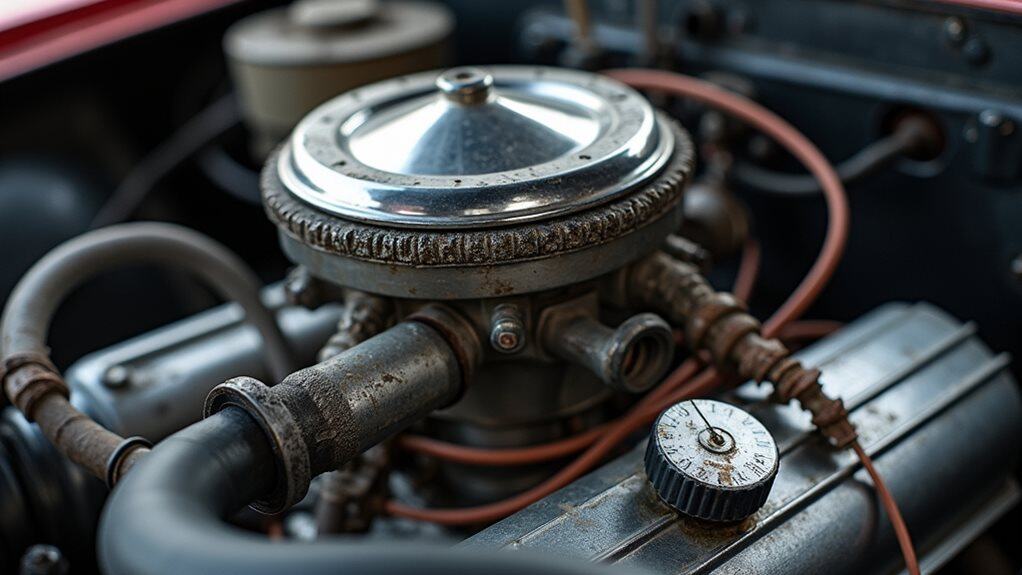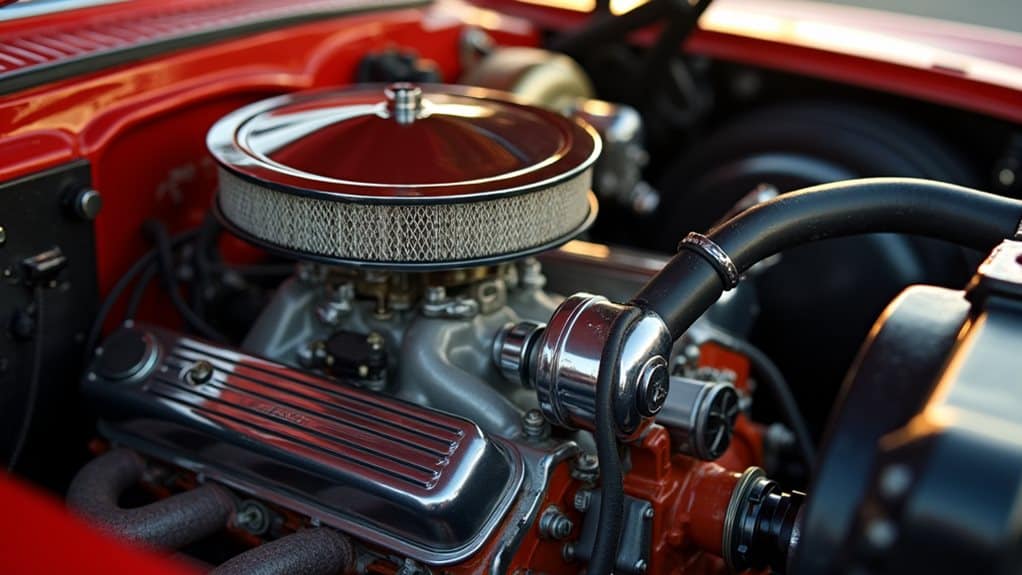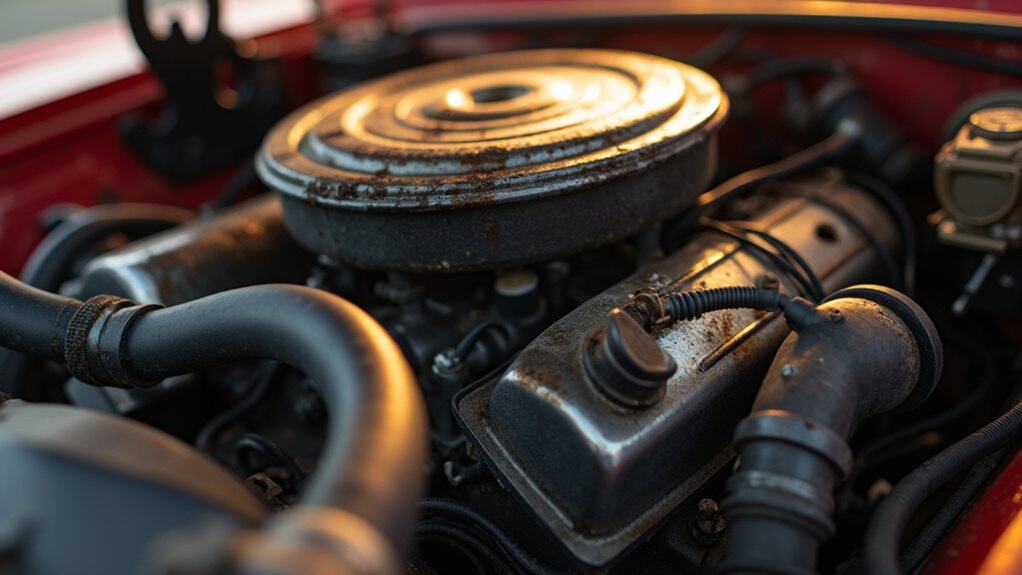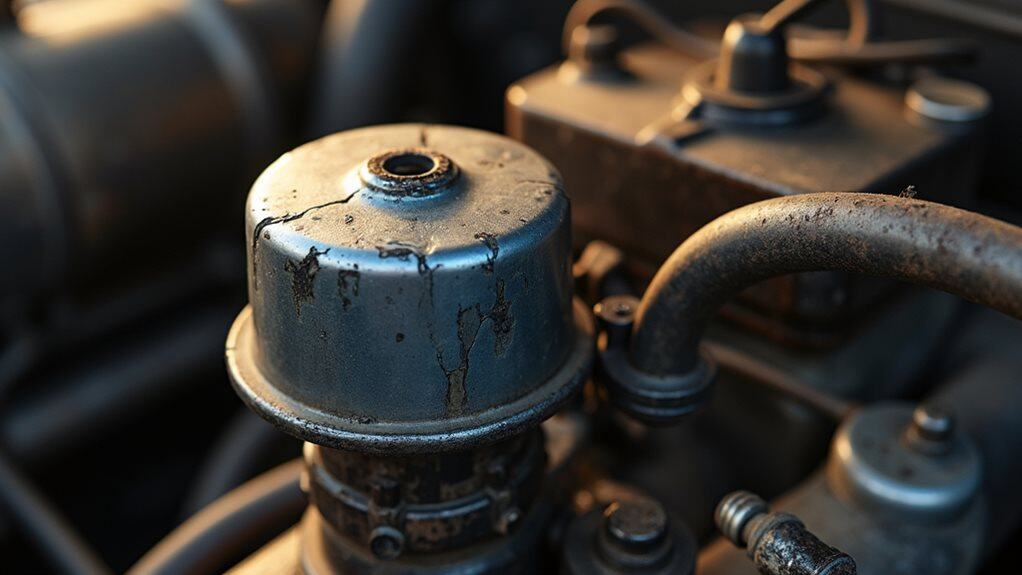If your vacuum advance is too aggressive, you’ll hear pinging or knocking at light throttle as spark fires early, and idle may surge or hunt because timing jumps too far; you might also get hesitation or stumbling on throttle application, detonation under light load, higher measured timing with vacuum connected, and sudden RPM spikes when the advance engages. Check for torn diaphragms or wrong vacuum source, since correcting those fixes many symptoms, and more diagnostic steps follow.
Quick Tips
- Metallic pinging or detonation at light throttle/part‑cruise due to overly early ignition timing.
- Idle speed hunting or surging as manifold vacuum continuously pulls advance, causing RPM to spike and fall.
- High measured idle timing (often 40°+ with vacuum connected) that drops significantly when vacuum is blocked.
- Hesitation, stumbling, or poor throttle response under light load from excessive advance-induced pre‑ignition.
- Reduced fuel economy and higher exhaust temps/emissions from increased cylinder pressures and inefficient combustion.
Engine Knocking or Pinging at Light Throttle

When your engine knocks or pings at light throttle, it’s often because too much vacuum advance is moving the ignition timing earlier than it should, so the spark ignites the air-fuel mixture before the ideal position; this early combustion raises cylinder pressure and produces the metallic, tapping noise you hear as pinging. You should check for vacuum leaks, faulty advance units, lean mixtures, and low-octane fuel. Poor fuel quality can also cause premature detonation and worsen the pinging if left unaddressed. An exhaust leak before the O2 sensor can contribute to a lean condition by misleading the sensor and upsetting the air/fuel ratio.
Surging or Unstable Idle RPM
If your idle speed is hunting—rising and falling instead of holding steady—excess vacuum advance is a likely cause and you should check the vacuum source and timing setup.
Manifold-connected vacuum can apply full advance at closed throttle, pushing timing too far and causing vacuum-induced fluctuations where RPM spikes and drops as combustion becomes uneven.
Try isolating the vacuum advance (disconnecting or switching to ported vacuum) and reviewing initial and mechanical advance rates to see if delaying or reducing advance smooths the idle. Additionally, confirm the distributor’s centrifugal advance curve and total advance match the engine’s needs. Also inspect related systems like the vacuum source and electrical health to rule out issues that can mimic timing-related symptoms.
Idle Speed Hunting
Frequently, you’ll notice the engine’s idle speed swinging up and down—this is called idle hunting, and it shows the motor’s struggling to keep a steady RPM.
You may see 600–1200+ RPM swings, sputtering or jerks.
Check the IACV, throttle body and cable, sensors, and intake for vacuum leaks; cleaning, adjusting, or replacing faulty parts usually restores consistent idle control.
Vacuum-Induced Fluctuations
Idle hunting often points you to fuel, air, or idle control faults, but similar RPM swings can come from the ignition side—specifically from excessive vacuum advance that’s applying too much timing at idle.
You’ll see surging, misfires, or high idle when manifold vacuum feeds advance, or when light mechanical springs add early advance; switching to ported vacuum or firmer springs usually stabilizes RPM.
Excessive Total Timing at Idle

When total ignition timing is advanced too far at idle, your engine starts burning the air-fuel mixture before the piston reaches the best part of its stroke, and that early combustion causes a cascade of problems you can both hear and measure.
You’ll notice knocking, rough idle, hard starting, higher exhaust temperatures, increased wear and poorer fuel economy; measure timing, adjust advance, and correct components.
This can also lead to increased cylinder pressure, which exacerbates knocking and component stress.
Hesitation or Stumbling During Acceleration
You may notice hesitation or stumbling the moment you open the throttle, and one common cause is incorrect vacuum advance hookup or an improperly set initial timing that lets the distributor add too much advance under acceleration.
Check vacuum source: manifold vacuum feeds cause excess advance, ported vacuum prevents it.
Also inspect accelerator pump operation and linkage, since delayed fuel delivery mimics timing-induced stumble.
A faulty vehicle speed sensor can also cause erratic engine behavior and contribute to stalling or hesitation, so verify the speed sensor is functioning properly.
Detonation or Pre‑Ignition Under Low Load

Although vacuum advance improves part‑throttle efficiency by advancing spark timing under high manifold vacuum, too much advance at low load can trigger detonation or pre‑ignition, so you need to recognize and correct it quickly.
You’ll hear metallic knocking during light cruising, especially at higher RPMs; coal‑like carbon or hot spots, low octane fuel, or worn engines make knock likelier, and blocking the vacuum line often stops it.
Sudden RPM Increase When Applying Vacuum Signal
When you hook a vacuum advance to manifold vacuum and see an unexpected idle surge, that’s often a sign the timing is being over‑aggressively advanced at idle.
Excessive advance moves the distributor plate too far, so combustion happens earlier and the engine speeds up suddenly during throttle changes or when the vacuum signal is applied.
Check whether the unit is tied to manifold versus ported vacuum and measure total advance with a timing light to confirm if timing, not a vacuum leak or other issue, is causing the RPM jump.
Unexpected Idle Surge
If the vacuum advance is tied to a constant manifold vacuum source instead of a ported one, you can get sudden idle surges where the engine rpm jumps well above the set idle; manifold vacuum is high at closed throttle, so it continuously pulls the advance canister and adds ignition timing when you want the timing retarded for a stable idle.
You should switch to ported vacuum or correct leaks, especially on street engines, to prevent timing-induced rpm spikes and unstable idle behavior.
Over‑Aggressive Timing
Because vacuum advance responds to changes in intake vacuum, an overly aggressive unit or the wrong vacuum source can make timing jump too far and too fast, causing a sudden RPM increase when you modulate the throttle.
You’ll notice RPM surges as vacuum advance adds too much spark advance at low load, making the engine oversensitive; check source, canister strength, and advance curve to correct it.
High Measured Timing With a Timing Light

A timing light can show very high total advance at idle when manifold vacuum feeds the vacuum advance canister, and you’ll often see the pointer jump well beyond the base timing mark—sometimes into the 40°+ range—once the canister is pulled in.
You should compare readings with vacuum connected and disconnected; a large drop confirms excessive vacuum advance causing unstable idle, surging, and misleading timing data.
Worn or Torn Vacuum Advance Diaphragm Symptoms
When you see unusually high timing readings on a timing light or notice the advance changing wildly with the vacuum hose connected, the vacuum advance diaphragm is one of the first components you should inspect.
Check for splits or audible air leaks by applying vacuum; no diaphragm movement, a disconnected or seized rod, or easy air flow through the hose indicates a torn diaphragm needing replacement.
Reduced Fuel Efficiency and Elevated Emissions

If your vacuum advance is supplying too much timing, you’ll usually see fuel economy drop and emissions rise because the mixture and combustion timing move out of their ideal ranges; over-advanced ignition causes incomplete combustion, which both wastes fuel and increases unburned hydrocarbons (HC) and carbon monoxide (CO).
You’ll notice poorer mpg, rough running or misfires, richer idle mixtures, higher HC/CO readings, and possible knock, so check timing with and without vacuum advance and verify the vacuum source and unit deployment.
Wrapping Up
You should check vacuum advance carefully, because too much advance affects timing, idle quality, and fuel use. If you hear pinging at light throttle, see idle surge, or measure high static timing with a timing light, reduce the vacuum signal or inspect the diaphragm for leaks. Correcting advance restores smooth acceleration, prevents detonation, and lowers emissions; use a calibrated gauge and follow the vehicle’s service manual for precise adjustment and safe testing procedures.

